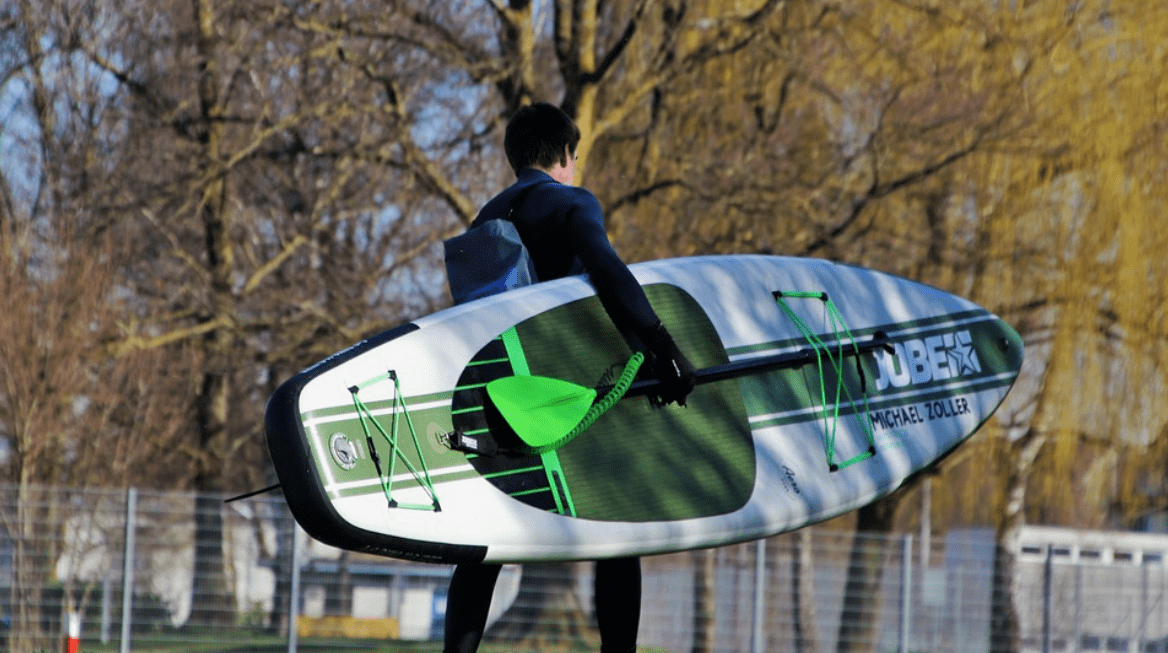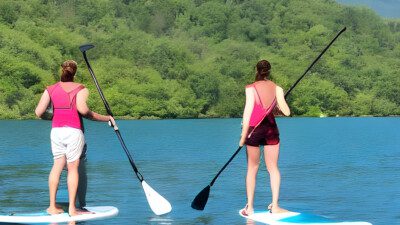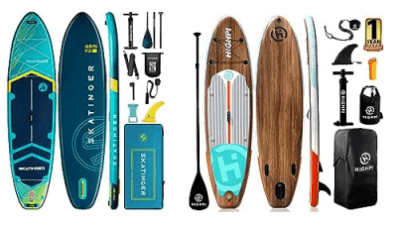Rigid vs Inflatable SUP: What’s the Difference?
For many years, rigid paddleboards were the go-to choice for those wanting a reliable and sturdy SUP. But nowadays, inflatable paddleboards hold their own against those options of the past. Advances in technology have allowed inflatables to become a dependable board, making them quite the competitor when you compare the features of a rigid vs inflatable SUP.
What sets these two SUP types apart from one another? Why would a paddler prefer an inflatable vs rigid paddleboard? What are the pros and cons of either kind? Determining the right board for you comes down to learning which SUP will meet your specific needs and expectations.

How Inflatable and Rigid Paddleboards Differ
SUP is an increasingly popular water sport, and the expanded interest has led designers to develop more innovative and technologically-advanced paddleboards. With the latest construction methods, manufacturing techniques, and material types, you are sure to find a SUP style that fits the bill.
Understanding Hard Paddleboards
First, let’s establish that hard paddleboards go by numerous names. If you see terms such as traditional, rigid, epoxy, or fiberglass, these titles refer to non-inflatable SUPs.
Advantages of Hard SUPs
To answer the question – “Which board is best, inflatable vs hard paddleboard?” – requires an individualized approach. You need to think about the purpose behind your board purchase and how you intend to use your SUP.
Performance: If you want a board that offers higher performance, hard SUPs are known to outperform inflatable boards. Hard paddleboards are for those that want to glide faster and use that momentum to maintain a quicker speed.
Shape: The shape of a board impacts its capabilities, and rigid SUPs are designed with performance in mind. Designers can alter the rails, nose, and tail of a hard paddleboard to match the abilities and weight of a rider.
Maneuverability: For a smooth and speedy riding experience, you need a board you can maneuver. Hard SUPs are agile and nimble, which makes for a better glide and improved tracking. You can even catch waves with a rigid paddleboard.
Time: If you want to hop out of your vehicle and get right into the water, you need a hard SUP. You won’t have to waste valuable riding time as you wait for your board to inflate. Then when the fun must come to an end, you won’t have to put in extra work to deflate your board either. Just load it up and go. No matter how you look at it, you get more time in the water with a rigid vs inflatable SUP. Plus, you won’t need to lug around extra equipment such as an air pump.
Disadvantages of Hard SUPs
Storage: Although a rigid board gets you in the water quicker, you must have a vehicle that can transport such a large item. Not just any kind of car can accommodate the size of a hard SUP. Not to mention, storing a gigantic board can be a hassle if you are tight on space.
Damage: Non-inflatable SUPs are not as forgiving as inflatable SUPs. You need to be prepared to manage this huge, heavy item. If you accidentally drop your rigid board, you can ding or crack your hardboard.
Understanding Inflatable Paddleboards
Inflatable SUPs adapt well to all environments and rider abilities. In particular, inflatable SUPs are beginner-friendly.
Advantages of Inflatables SUPs
Weight Capacity: Inflatables tend to have a higher weight capacity than hard paddleboards. That means you can carry cargo with you, bring along a dog, or even have another rider join you on your board. You lose buoyancy or increase your risk of capsizing when you exceed the maximum payload.
Rider Fatigue: Hard SUPs are just that – a hard surface that you are expected to stand on for hours. If you plan to go on long adventures, your feet, knees, and back will thank you if you choose to ride on the soft surface of an inflatable SUP.
Protection: That soft surface provides more than just a comfortable ride. As a paddleboarder, you can expect to encounter some bumps and bruises on your journey. You will experience firsthand just how hard and heavy a rigid SUP is when you come crashing down on it or the board hits you in the water.
Stability: All the design elements of an inflatable board work toward providing stability for a paddler. From the material type, shape, width, thickness, volume, and size, an inflatable vs solid paddleboard is generally the more secure ride.
Recreational Use: Not everyone needs a paddleboard for performance purposes. If you are more about enjoying a yoga session on your board than participating in a competitive race, an inflatable is everything you need.
Storage: To transport an inflatable SUP, simply free up a space comparable in size to a large suitcase. No special roof racks required. And if you plan to travel on an airplane to your paddleboarding destination, checking your inflatable SUP at the airport shouldn’t be a problem. No expensive fees for oversized items.
Disadvantages of Inflatables SUPs
Longevity: Technology has come a long way since the first inflatable was manufactured, but no paddleboard is invincible. PVC materials and the glue or stitches holding that PVC together can wear out over time, and as luck would have it, you could encounter a broken seam that would interrupt your paddleboarding plans.
Wind: Windy conditions are not ideal when riding an inflatable SUP. The lightweight nature of an inflatable vs hard paddleboard make paddling in even a light wind quite the challenge.
Inflatable vs Solid Paddleboard: Is One Better Than the Other?
There is no right or wrong answer to whether you should go with a rigid vs inflatable SUP. To determine the best choice for your personal situation, you need to consider why you want a paddleboard and what you hope to accomplish with that board.
If you are looking into hard SUPs:
Check out the ISLE Versa Rigid Stand Up Paddleboard
or the WAVESTORM 9ft6 SUP Kayak Hybrid Stand Up Paddleboard
If you think an inflatable paddleboard might be a better fit:
Look at the SereneLife Inflatable Stand Up Paddleboard
or Roc Inflatable Stand Up Paddleboard
And for all your water sports needs, don’t forget to use the WakeScout Directory to find worldwide listings for:
- Cable Wake Parks
- Water Sport Schools
- Water Sport Clubs
- Water Sport Resorts
- Water Sport Charters
- Ski and Wake Boat Rentals
WakeScout will help get you on the water…anywhere in the world!
Other wakescout blog articles
7 Best Places to Paddleboard in Colorado
For many years, rigid paddleboards were the go-to choice for those wanting a reliable and sturdy SUP. But nowadays, inflatable paddleboards hold their own against those options of the past. Advances in technology have allowed inflatables to become a dependable board, making them quite the competitor when you compare the features of a rigid vs inflatable SUP. What sets these two SUP types apart from one another? Why would a paddler prefer an inflatable vs rigid paddleboard? What are the pros and cons of e...





